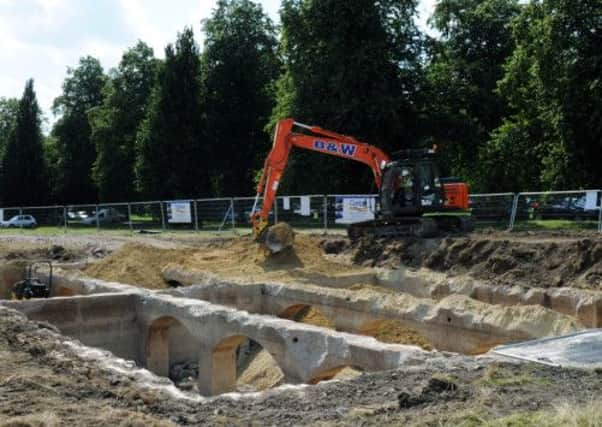Spa town’s caves set to disappear


For beneath the Stray, one of Harrogate’s most famous landmarks, are forgotten underground caverns that were once used to store thousands of gallons of mineral water for the town’s world famous spas.
Concealed from prying eyes and potential intruders for many years, work is now underway to fill the chambers in as part of efforts to ensure the giant reservoirs do not collapse.
Advertisement
Hide AdAdvertisement
Hide AdThe forgotten Harrogate caverns have been described as an “extraordinary legacy of Victorian times” and some have questioned the need for them to be filled in.
In a statement the Duchy of Lancaster said: “The disused reservoir beneath the Stray has been stable over the last few years. However, as with all structures, it is degrading over time.
“As part of its commitment to Harrogate, the Duchy has used its own private money to fill the reservoir and thereby safeguard the Stray’s continued use.”
Work has already begun on the project which has already seen the caverns excavated and yesterday lorries could be seen bringing material to the site on the Stray near Christ Church.
The Duchy said it expected the work to last a few weeks.
Advertisement
Hide AdAdvertisement
Hide AdThose who travelled to the developing spa town to take the waters believed their aches, pains and other ailments would be eased away.
In its hey day Harrogate attracted people from far and wide and, at its peak, each summer the Royal Pump Room had some 15,000 visitors.
Among its most famous visitors was Tsarina Alexandra of Russia in 1911.
There were some who found the sulphurous waters invigorating while others were less keen, turning their noses up at the malodorous qualities that helped give the town international recognition, dubbing them “the stinking spaw” because of their acquired smell.
Advertisement
Hide AdAdvertisement
Hide AdWhile many came to drink the water, others underwent a range of treatments, which included peat and saline sulphur baths, which held the promise to cure a range of ills from gout to rheumatism.
The medicinal baths employed bath attendants and masseurs and offered a range of hydrotherapy treatments.
Alkaline sulphur baths were mainly used for skin diseases, and alkaline sulphur electric baths, with a range of currents used to treat muscle weakness.
After the Second World War, however, when the priorities of life switched to more harsher realities, the Pump Room attracted fewer visitors and with the emergence of the country’s National Health Service the “curing” waters were not taken as frequently and eventually the doors were closed.
Advertisement
Hide AdAdvertisement
Hide AdThe cavern works being undertaken clearly reveal the reservoirs, used to store up to 20,000 gallons of water, which were first built under the Stray in 1901 when demand was high and officials were keen to ensure plentiful supplies.
But as appetites declined for treatments so did the need to store the waters and for years they have lain abandoned, and forgotten underground.
The exact location has been kept a secret as the authorities wanted to stop people getting in. Local children in the 1960s and 1970s were urged to avoid the Stray Caverns and eventually they slipped from memory.
The work being carried out is intended to ensure they are safe but some locals have raised concerns questioning the need, claiming the move is a waste of money and prompted by unfounded health and safety fears.
Advertisement
Hide AdAdvertisement
Hide AdBut last night, The Duchy of Lancaster said: “For many years, the Duchy of Lancaster has provided the Stray as a public open space for the benefit of the people of Harrogate.
“Although maintained on a day-to-day basis by the council, as the landowner, the Duchy wishes to ensure the safety of people who use the land.
“The Duchy has carried out the work in cooperation with Harrogate Borough Council, who maintain the park, and has all the necessary permissions required.”